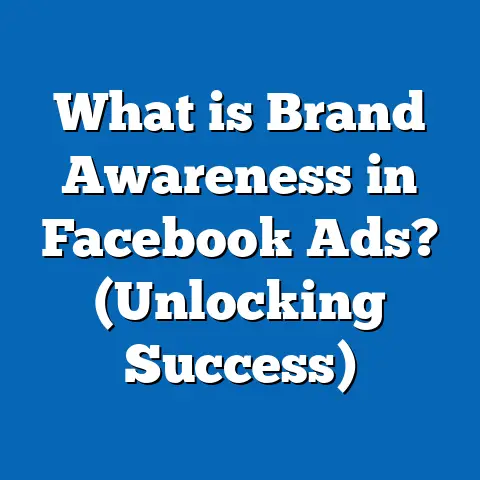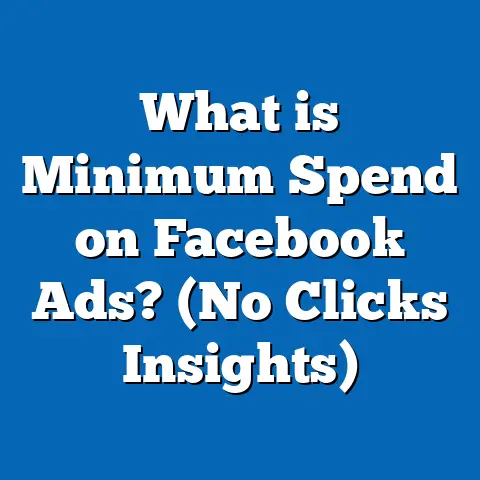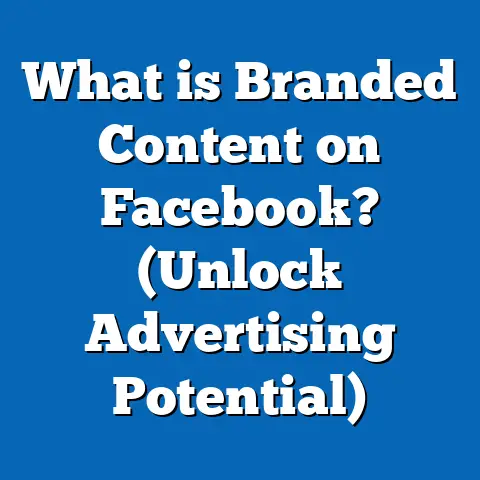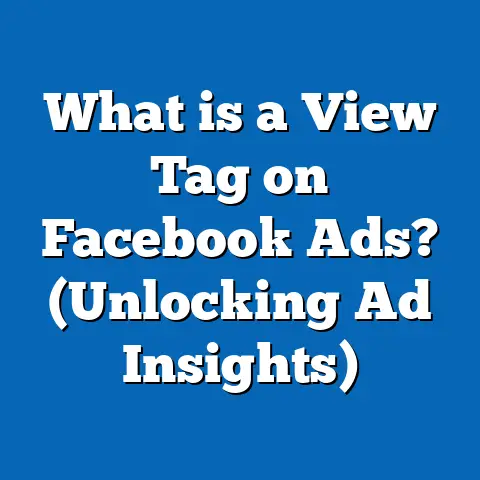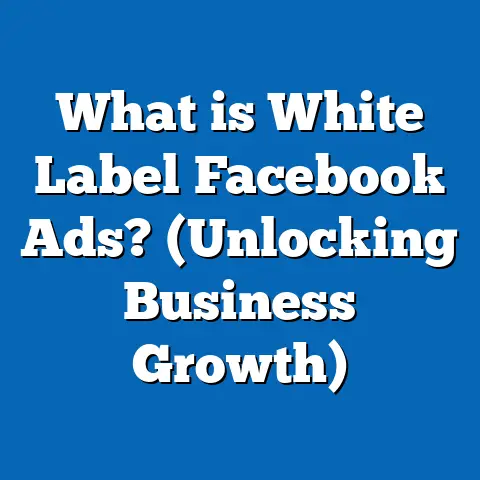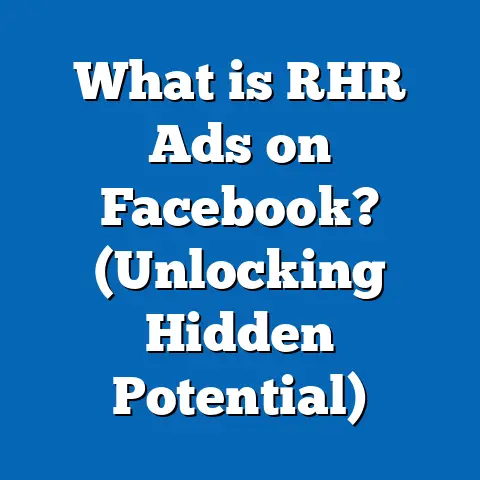What is Footfall Facebook Ads? (Boost In-Store Visits Today)
What is Footfall Facebook Ads? (Boost In-Store Visits Today)
Have you ever wondered how to turn your online ads into real-world customers walking through your store doors? In today’s digital-first world, driving physical foot traffic to brick-and-mortar locations remains a critical challenge for retailers and local businesses. Facebook, with its vast user base and powerful targeting tools, offers a specialized solution known as Footfall Facebook Ads — designed specifically to boost in-store visits.
Understanding Footfall Facebook Ads
What Are Footfall Facebook Ads?
Footfall Facebook Ads are a type of location-based advertising campaign focused on increasing the number of people who visit a physical store or business location. Unlike traditional online ads that seek clicks or conversions on a website, these ads are optimized to drive real-world foot traffic.
Using Facebook’s robust location targeting and tracking technologies, advertisers can:
- Target audiences within a specific geographic radius.
- Deliver personalized messages that encourage store visits.
- Measure effectiveness based on actual customer visits.
Footfall ads are part of Facebook’s broader suite of objective-based campaigns. They fall under the “Store Traffic” or “Local Awareness” objectives in Facebook Ads Manager. These objectives are designed to help businesses reach people near their physical locations with the goal of increasing foot traffic.
Why Footfall Ads Matter in Retail Marketing
Despite the growth of e-commerce, physical retail stores still generate approximately 85% of total retail sales globally (eMarketer, 2023). For many businesses, in-store visits lead to higher average order values and stronger customer relationships.
Why is this important? Because physical presence allows customers to:
- Experience products firsthand.
- Receive personalized customer service.
- Build trust and brand loyalty through in-person interactions.
With competition rising both online and offline, footfall campaigns help businesses:
- Capture local audiences actively nearby.
- Bridge the gap between digital engagement and physical sales.
- Optimize marketing spend toward measurable real-world outcomes.
Moreover, many consumers research products online before purchasing in-store. This omnichannel behavior creates an opportunity for businesses to use digital ads as a nudge to bring these customers physically into stores.
How Footfall Facebook Ads Work: The Technology Behind It
Location Targeting Capabilities
Facebook uses several layers of location data to serve footfall ads effectively:
- GPS data from mobile devices: Ensures ads are served to users physically near your store.
- Wi-Fi triangulation and IP address: Helps refine targeting in areas with poor GPS signal.
- Check-ins and location history: Allows for behavioral retargeting of previous visitors.
Advertisers can define precise geographic boundaries using:
- Radius targeting (e.g., 1km around the store).
- Specific zip codes or neighborhoods.
- Custom geofences for multiple store locations.
Facebook aggregates this data anonymously and complies with privacy regulations like GDPR and CCPA to protect user privacy while enabling precise targeting.
Measuring Store Visits: Offline Conversions Tracking
One of the most valuable features of Footfall Facebook Ads is the ability to measure offline conversions. This means linking digital ad interactions to real-world actions such as in-store visits or purchases.
Businesses can upload their point-of-sale (POS) data or use third-party integrations to track:
- Number of customers visiting post-ad exposure.
- Incremental sales attributed to the campaign.
- Customer frequency and lifetime value impact.
This tracking uses hashed customer data (e.g., email addresses or phone numbers) to match ad viewers with actual purchasers without compromising privacy.
Facebook’s Store Traffic Objective vs. Other Objectives
Footfall ads typically use the “Store Traffic” objective which optimizes delivery to people most likely to visit your store. This differs from objectives like “Conversions” or “Traffic” which focus on online actions like clicks and purchases on websites.
Choosing the right objective is critical because Facebook’s machine learning optimizes ad delivery based on the selected goal.
Why Use Footfall Facebook Ads? Key Benefits
1. Drive Qualified Local Traffic
Facebook’s precise location targeting ensures your ads reach people most likely to visit your store based on proximity and behavior. According to Facebook data, 60% of people discover new places through social media ads (Facebook Insights, 2024).
2. Increase Sales and Boost ROI
According to Facebook Business reports, businesses running footfall ads see an average 20-25% increase in store visits within the first three months.
Retailers using footfall campaigns report an average Return On Ad Spend (ROAS) of 6:1, meaning every $1 spent generates $6 in revenue from in-store sales.
3. Improve Campaign Optimization
With real-time data on store visits, marketers can adjust bids, creatives, and audience segments dynamically to improve performance. This continuous optimization reduces wasted spend and improves efficiency.
4. Enhance Customer Insights
Footfall campaigns provide valuable data on which locations perform best and which demographics are most responsive, helping tailor future marketing efforts. For example, you might discover that women aged 25-34 living within 3km respond best to your ads — allowing you to focus budget on this segment.
5. Complement Omnichannel Marketing Efforts
Footfall Facebook Ads integrate well with other channels like email marketing or SMS campaigns by reinforcing messaging both online and offline. This creates a cohesive shopping experience that drives customer loyalty.
Key Metrics to Track in Footfall Facebook Ads
When running footfall-focused campaigns, these metrics are essential:
| Metric | Definition | Why It Matters |
|---|---|---|
| Store Visits | Number of people who physically visited the store | Core measure of campaign success |
| Cost Per Store Visit (CPSV) | Spend divided by total store visits | Helps evaluate cost efficiency |
| Offline Sales | Revenue generated from in-store purchases linked to ads | Direct measure of ROI |
| Return on Ad Spend (ROAS) | Revenue divided by ad spend | Overall profitability indicator |
| Foot Traffic Lift | Increase in visits compared to baseline period | Shows incremental impact from ads |
| Frequency | Average number of times an individual sees the ad | Helps avoid ad fatigue |
| Engagement Rate | Likes, comments, shares on the ad | Indicates ad relevance and resonance |
Tracking these metrics consistently allows marketers to understand what works best and scale successful tactics accordingly.
Crafting Effective Footfall Facebook Ads: Strategy and Best Practices
Step 1: Define Your Objective Clearly
Set measurable goals such as:
- Increase daily foot traffic by 15%.
- Boost weekend store visits by 30%.
- Drive repeat visits from existing customers.
- Reduce cost per visit below $5 within three months.
Clear objectives guide campaign setup and help measure success accurately.
Step 2: Identify Your Target Audience
Leverage Facebook’s audience tools:
- Local awareness audiences: People living or frequently near your store.
- Lookalike audiences: Users similar to your best customers.
- Custom audiences: Past visitors or loyalty program members.
- Behavioral targeting: Focus on people who recently moved into the area or frequently visit competitor locations.
Example: For a gym, target users within a 3km radius who have shown interest in fitness-related pages or groups.
Step 3: Design Compelling Creatives
Use visuals and copy that emphasize urgency and local relevance:
- Highlight exclusive in-store promotions or events.
- Showcase new product arrivals only available in-store.
- Use clear calls-to-action like “Visit us today” or “Show this ad for a discount.”
- Incorporate customer testimonials or images of happy shoppers inside your stores.
Example headlines:
- “Spring Sale – Visit our downtown store for exclusive deals!”
- “Limited time offer! Show this ad for 10% off in-store.”
Step 4: Set Up Precise Location Targeting
Focus on areas where potential customers live, work, or commute. Test different radius sizes (500m to 5km) based on store type and urban density.
Urban convenience stores may benefit from smaller radii (up to 1km) while regional malls may target broader areas (up to 5km).
Step 5: Leverage Offline Conversion Tracking
Ensure POS data integration for accurate measurement of foot traffic and sales attributed to ads. Use tools like:
- Facebook Offline Conversions API.
- CRM platform integration.
- Manual data uploads for smaller businesses.
Step 6: Schedule Ads Strategically
Run ads during peak shopping times or immediately before store hours to maximize relevance. Consider dayparting:
- Grocery stores might run ads early morning for breakfast shoppers.
- Fashion retailers could focus on weekends or evenings.
Step 7: Optimize Continuously
Analyze performance weekly:
- Adjust bids for better-performing locations.
- Refresh creatives every 2–3 weeks to avoid ad fatigue.
- Modify audience segments based on engagement data.
Detailed Case Studies Demonstrating Footfall Facebook Ads Success
Case Study 1: Local Coffee Shop Chain
Background: A regional coffee shop chain wanted to increase morning rush hour traffic amid stiff competition from international brands.
Challenge: Attract nearby office workers and commuters during peak hours (7 AM – 10 AM).
Strategy:
- Geo-targeted users within a 2 km radius near each shop.
- Scheduled ads during morning hours only.
- Offered “Buy one get one free” coupons redeemable in-store.
- Used short video clips showing fresh coffee preparation.
Results After 6 Weeks:
- Morning foot traffic increased by 28%.
- Average CPSV dropped by 15% due to better targeting.
- Sales increased by 22% compared to previous quarter.
Takeaway: Combining time-based scheduling with localized offers maximized relevance and drove results.
Case Study 2: Boutique Clothing Store
Background: A boutique clothing brand aimed to boost weekend shoppers during seasonal sale events.
Challenge: Compete with larger retailers while driving high-value customers into stores.
Strategy:
- Created custom audiences from past purchasers via CRM data.
- Geo-targeted affluent neighborhoods within a 5 km radius.
- Highlighted limited-time discounts with countdown timers.
Results Over a Month:
- Weekend foot traffic doubled during sale days.
- ROAS reached an impressive 8:1.
- Customer retention improved by 12% over three months due to follow-up retargeting campaigns.
Takeaway: Using CRM data to create custom audiences combined with geo-targeting can significantly boost local sales events.
Case Study 3: National Electronics Retailer
Background: Large electronics chain wanted to increase foot traffic for new product launches across multiple locations.
Challenge: Reach tech enthusiasts near each store while measuring offline sales impact.
Strategy:
- Created separate campaigns for each city with localized creatives featuring new gadgets.
- Used lookalike audiences based on previous product buyers.
- Integrated POS data with Facebook Offline Conversions API.
Results After Three Months:
- Store visits increased by 35%, with spikes during launch weeks.
- Offline sales from footfall campaigns accounted for 27% of total revenue growth.
Takeaway: Multi-location campaigns paired with robust offline tracking enable large brands to quantify real-world impact precisely.
Comparing Footfall Facebook Ads With Other Platforms
| Feature | Facebook Footfall Ads | Google Local Campaigns | Instagram Location Ads |
|---|---|---|---|
| Audience Size | Largest social network worldwide | Broad search-based audience | Highly visual, younger demographic |
| Location Targeting | Precise GPS and geo-fencing | Based on search intent/location | Similar geo-targeting powered by Facebook infrastructure |
| Measurement Tools | Offline conversion tracking integration | Google Store Visits reporting | Limited offline tracking options |
| Creative Formats | Image, video, carousel, stories | Search ads, display banners | Stories, Reels, feed posts |
| Integration with CRM | Strong integrations available | Google My Business integration | Via Facebook Business Suite |
| Cost Efficiency | Typically lower CPSV due to social engagement | Higher CPC but good intent targeting | Good engagement but less focused on foot traffic |
Advanced Tips for Maximizing Footfall Facebook Ads
Use Dynamic Creative Optimization (DCO)
Let Facebook automatically test different combinations of images, headlines, and CTAs. This helps find the best-performing ad variations tailored for foot traffic campaigns without manual A/B testing.
Geo-Fencing Competitor Locations
Target users near competitors’ stores with compelling offers designed to sway their shopping decisions. Example: A local gym running promos targeting users within 500m of a rival gym during peak hours.
Schedule Ads by Store Hours
Run ads only during operational hours or just before peak shopping times. This avoids wasting budget showing ads when stores are closed or customers cannot visit.
Combine with Retargeting Campaigns
Retarget users who interacted with your ad but did not visit the store with follow-up incentives such as exclusive coupons or event invitations.
Leverage User Generated Content (UGC)
Ads featuring real customer photos or reviews build trust and authenticity that encourage physical visits more than generic stock images.
Industry Trends Impacting Footfall Advertising
Increased Mobile Device Usage
Mobile devices account for over 70% of Facebook ad impressions, making location-based targeting more effective since mobile GPS data is more accurate than desktop IP addresses.
Privacy Regulation Impact
Apple’s iOS updates require explicit consent for tracking apps via App Tracking Transparency (ATT). Advertisers must adapt by encouraging opt-ins or using aggregated measurement methods like Facebook’s Aggregated Event Measurement (AEM).
AI-driven Automation
Facebook’s machine learning optimizes ad delivery toward users most likely to visit stores without manual intervention — improving efficiency especially for multi-location campaigns.
Omnichannel Integration
Combining digital engagement data with offline sales creates seamless customer journeys that enhance foot traffic campaigns. For example, syncing email marketing lists with offline purchase data helps create personalized follow-ups driving repeat visits.
Rise of Augmented Reality (AR) Shopping Experiences
Some brands use AR filters integrated with footfall ads that allow virtual try-ons or previews before encouraging store visits — blending digital interaction with physical shopping experiences.
Common Challenges and How to Overcome Them
| Challenge | Solution |
|---|---|
| Inaccurate location data | Use multiple data sources; verify geofencing settings; encourage users to enable location services |
| Privacy concerns | Be transparent about data use; comply with GDPR/COPPA; provide clear opt-out options |
| Attribution difficulties | Implement robust offline conversion tracking solutions; use multi-touch attribution models |
| High competition in local area | Use unique offers; hyper-local targeting; leverage community partnerships for co-promotions |
| Ad fatigue | Rotate creatives regularly; use frequency caps; introduce seasonal themes |
| Measuring long-term impact | Combine footfall data with CRM insights on repeat visits and lifetime value analysis |
Step-by-Step Guide: Setting Up Your First Footfall Facebook Ad Campaign
Step 1: Prepare Your Business Assets
Before launching:
- Ensure your business location(s) are verified on Facebook.
- Have your POS system ready for offline conversions integration.
- Gather customer contact information for custom audiences if applicable.
Step 2: Create Campaign in Facebook Ads Manager
- Choose objective: Select “Store Traffic” or “Local Awareness.”
- Name your campaign clearly for easy management (e.g., “Downtown Store Footfall May 2025”).
Step 3: Define Your Audience
- Set location targeting radius around your store(s).
- Add demographic filters if needed (age, gender).
- Include interests or behaviors relevant to your business niche.
- Use custom/lookalike audiences if available.
Step 4: Set Budget and Schedule
- Choose daily or lifetime budget depending on campaign length.
- Schedule ads during hours when stores are open or peak shopping times.
Step 5: Design Your Ads
- Select format (single image/video/carousel/stories).
- Upload high-quality visuals emphasizing local connection.
- Write concise copy with strong call-to-action like “Visit us today!”
- Include special offers if available (“Show this ad for 10% off”).
Step 6: Set Up Offline Conversions Tracking
- Integrate your POS system via API or manual uploads.
- Configure parameters such as purchase value mapping.
- Enable reporting for store visits attributed to ads.
Step 7: Review and Publish Campaign
Double-check all settings then launch the campaign.
Example 2 – Retail Store Seasonal Sale
Headline: Spring Sale Now On!
Text: Refresh your wardrobe with up to 50% off selected items at our Uptown boutique. Offer valid till Sunday!
Creative: Carousel featuring best-selling outfits with price tags highlighted.
Example 3 – Fitness Center Membership Drive
Headline: New Year, New You!
Text: Join our gym today and get your first month free! Located just around the corner – come visit us!
Creative: Video tour of gym facilities including trainers and group classes footage.
Tools & Resources To Support Footfall Facebook Ad Campaigns
| Tool/Resource | Purpose |
|---|---|
| Facebook Business Manager | Central platform for campaign management |
| Facebook Offline Conversions API | Tracks offline sales linked to ads |
| CRM Software (e.g., HubSpot, Salesforce) | Manage customer data & integrate with FB |
| Location Analytics Tools | Analyze foot traffic patterns (e.g., Placer.ai) |
| Creative Design Tools (e.g., Canva) | Create compelling visuals |
| Google My Business | Manage local listings & reviews |
Final Thoughts and Next Steps
Footfall Facebook Ads provide an unmatched opportunity for businesses looking to connect their digital marketing efforts directly with physical store visits. By leveraging location technology, offline conversion tracking, and targeted creative strategies, you can:
- Drive qualified local traffic efficiently.
- Increase revenue through measurable real-world results.
- Gain deeper insights into customer behavior near your stores.
The key is starting small—test different targeting radii, creative formats, and offers—and then scale what works best using continuous optimization informed by accurate offline sales data.
If you haven’t yet explored footfall campaigns, now is the time. With evolving consumer behaviors favoring hybrid shopping experiences between online browsing and offline purchasing, mastering Footfall Facebook Ads will give you a competitive edge in today’s complex retail environment.
This guide is designed for marketing professionals and business owners aiming to deepen their understanding of location-based advertising via Facebook while equipping them with actionable strategies proven by data and case studies.

